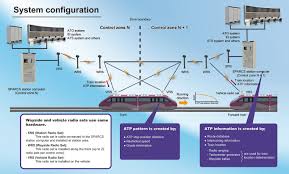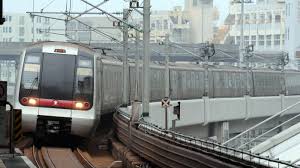Metro Rail Control of Signaling Safety Communication Running Lines
(1) Control of Signaling :- (i) Main line signaling is controlled from an Operations Control Center and operates normally under automatic control with routes being set and train intervals regulated by computer control.
(ii) Signaling system will permit more than one train at a time in one Tunnel Ventilation Section. This can be restricted to one train in one Tunnel Ventilation section in case of emergencies, and in a case the Traffic Controller decides to send additional trains in a Tunnel Ventilation section already occupied by a train, he shall set the route manually for additional 18 trains and shall advise train operators about this before authorizing them to proceed.
(iii) the Traffic Controller, if required, may hand over control of the signals of a specific station to the Station Controller and a local control panel or work-station shall be provided at the station for this purpose.
(iv) in case of complete failure of control from Operations Control Center, the entire control may be transferred to a standby backup control center, if provided at an alternate location, which may be at separate locations for traffic control and control of traction power.
(v) the Traffic Controller shall have control of all routes on and to the main line as specified.
(vi) train movement shall normally be under computer control but the Traffic Controller has the capability of setting routes manually and of setting individual points, if necessary.
(2) Safety Communication :- (i) all communication between Operations Control Center and train operators, Station Controller, maintenance staff of electrical, rolling stock, signal and telecommunication and track structures department and other pertaining to movement of trains shall be recorded with time st amping and preserved for incident analysis and training and the mode of preservation and its duration shall be specified in special instructions.
(ii) the Metro Railway employees shall initiate and acknowledge radio messages in a manner that ensures establishment of communication only between intended parties.
(iii) messages affecting train movements shall be addressed by the Traffic Controller to only one train at a time: Provided that in an emergency, a blanket message may be sent by the Traffic Controller to all trains in or approaching a particular area, which must be acknowledged individually by all concerned train operators: Provided further that in an emergency, such message may be given by the Station Controller, if authorized by the Traffic Controller in this behalf.
(3) Running Lines :- (i) the Signaling system on the running line shall be an Automatic Train Protection system;
(ii) if the speed which permits a train running on Automatic Train Protection to stop under normal braking within a limit of safety, 19 is exceeded, and the Train Operator fails to take corrective action on the alarm generated, an irrevocable emergency brake shall automatically apply which ensures that the train does not proceed beyond the safe limit.
(iii) normal operation of the train running on Automatic Train Protection is monitored from indication on the train operator’s console and each main running line is duly signaled for operation.
(iv) certain lines are equipped for automatic train operation with provision for the Train Operator to assume manual control of the train if required.
(v) in the event of failure of the Automatic Train Operation equipment and on lines not so equipped, train operators shall control their train up to the speed indicated on the console.
(vi) where no cab indication is available, train shall be automatically restricted to a maximum speed of twenty five kilometers per hour.
(vii) fixed signals are provided at approach to all points and crossings of the interlocked area, and certain other locations.
(4) (i) Station Controller’s control panel or work-station shall have the capability of setting routes within the area of control, and of setting individual points when necessary.
(ii) on each platform andin station control room , there shall be emergency stop plunger, which when operated shall cause any approaching train to stop before it enters the platform. In this situation any train entering, stationary or leaving the platform shall experience a full irrevocable emergency brake application.
(5) (i) The depot tracks may not be equipped with full complement of Automatic Train Protection and trains shall be automatically restricted to a maximum speed of twenty five kilometers per hour and the Train Operator may further restrict the speed of the train in the depot lines to a lower value as provided in the special instructions.
(ii) movements within depots shall be controlled by fixed colour light signals or position light type signals.
(iii) control of movements within the depot shall be exercised by a Depot Controller from a control panel or work-station located within the depot or at some other suitable location.
(iv) the Depot Controller shall use a control panel or work-station for setting and clearing of routes within the depot;
(v) instructions to train operators as to which siding they shall drive or give permission to depart may be given by train radio on a 20 dedicated depot channel distinct from that used by Operations Control Center.
(vi) in the event of the failure of the radio, a Public Address system may be used.
(vii) a verbal instruction as well as proceed indication from the fixed signals shall be received before a train may move into a depot from main-line.
(viii) both verbal instruction and proceed indication from the fixed signals shall be received before a train may move into main line from a depot.
(6) (i) Local operation of points on running lines as and when required may only be undertaken by a Station Controller with the permission of the Traffic Controller. Such transfer of control should be acknowledged by the station controller before the local control can be activated.
(ii) the crank handle used to manually operate the points is interlocked through a key which, when released by t h e Station Controller, shall inhibit setting of routes over the points concerned.
(iii) some points in depots may be trainable. In the event of a route failure they need not be correctly set before a movement is authorized over them in the trailing direction. The non trainable points shall be protected by fixed signals or stop boards. Backing of trains over trainable points is strictly prohibited.
(7) (i) Where Some lines of the network are equipped with Automatic Train Operation, the Train Operator shall close the train doors and start the train from a station and monitor its functioning.
(ii) all Passenger trains shall be equipped with Automatic Train Protection equipment and can be driven manually under the control of the Automatic Train Protection system.
(iii) if Automatic Train Protection information is not available from the track side equipment, the train can be driven with traffic controller’s permission in “Run On Sight” mode, or in “Restricted Manual” Mode, where the train is not equipped with Run On Sight mode, in which the on board Automatic Train Protection equipment restricts the speed of the train to twenty five kilometers per hour and when the Automatic Train Protection information is again available from the track, the mode automatically upgrades to Coded Manual.
(iv) if the Automatic Train Protection is not available from the track or loco or cab side equipment due to fault or otherwise, the train may be driven with Traffic controller’s permission in ‘Restricted Manual’ mode, and in this mode the on board Automatic Train Protection equipment restricts the speed of the train to twenty five Kilometers per hour, this mode shall be used in depots and exceptionally on running lines when authorised by the Traffic Controller.
(v) if the on board Automatic Train Protection equipment is also defective, the train may be driven in High Speed Cut out Mode, where available, or Low Speed Cut out Mode, as authorized by Traffic Controller and when so authorized by the Traffic Controller, the Train Operator may open and operate a sealed switch and drive the train without Automatic Train Protection and in this mode the Train Operator shall limit the speed of the train at forty kilometers per hour in High Speed Cut Out Mode, where available, and twenty five kilometers per hour in Low Speed Cut Out Mode and be responsible for safe movement of the train.


